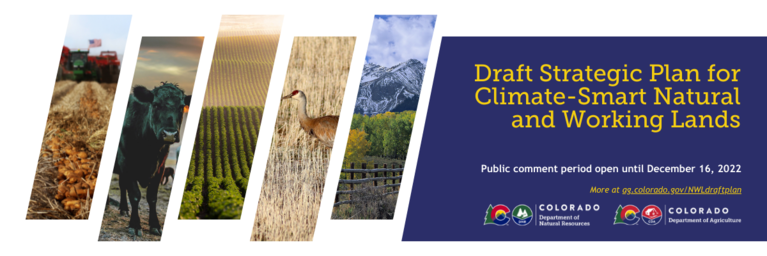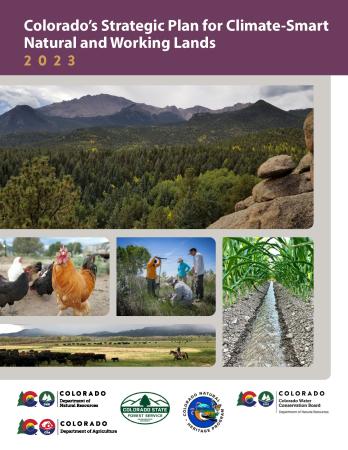Strategic Plan for Climate-Smart Natural and Working Lands
The State of Colorado, including the Department of Natural Resources, Department of Agriculture, Colorado State Forest Service, and Colorado Natural Heritage Program, developed the state’s first ever draft Strategic Plan for Climate-Smart Natural and Working Lands.
This Strategic Plan identifies priority actions across Colorado’s landscapes to reduce emissions, increase carbon sequestration, and create a climate resilient Colorado.
The Strategic Plan for Natural and Working Lands was a priority action in the 2021 Greenhouse Gas Pollution Reduction Roadmap and is meant to drive a broader strategic vision. The plan represents Colorado’s first coordinated effort to address greenhouse gas emissions from natural and working lands.
The report highlights existing programs that support resilient natural and working lands and identifies the needs for both additional data and dedicated capacity to carry on this work. Many climate-smart land management practices have positive co-benefits for ecosystems and communities. These cross-cutting solutions include avoiding land conversion, supporting water-smart land management, and protecting wildlife habitat and biodiversity.
In partnership with the Colorado Department of Natural Resources.
Background
Colorado’s Strategic Plan for Climate-Smart Natural and Working Lands was identified as a near-term priority action to reduce GHG pollution in Colorado’s GHG Pollution Reduction Roadmap, published in 2021.
The Strategic Plan summarizes actions, including existing programs, that enhance carbon sequestration and reduce GHG emissions from natural and working lands: croplands, rangelands, forests, grasslands and shrublands, wetlands and riparian areas, and urban green spaces. This work compliments climate action by other departments to reduce emissions from energy, transportation, industry, and other sectors.
This plan is the first of its kind for Colorado, and highlights the need for further research and understanding of how our natural and working lands interface with the state’s greenhouse gas emissions goals and climate resilience goals.
The Plan also recognizes that the state’s natural and working lands are managed by a wide range of entities- from farmers and ranchers to local entities to the federal government– and all these land managers will need to work together to create a resilient Colorado.
In November 2022, Colorado Department of Agriculture and Colorado Department of Natural Resources sought feedback from stakeholders through an open comment period on the draft of the plan. More than 50 comments were submitted and feedback was incorporated in the final plan, released in June 2023.
Public Comment Presentation on the Strategic Plan
You can view the slide show presentation of the final draft of the plan (November 2022) below.


